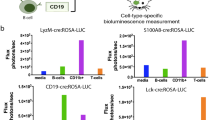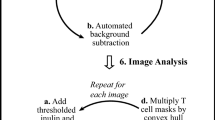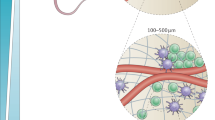Abstract
Here we present methods to longitudinally track islet allograft–infiltrating T cells in live mice by endoscopic confocal microscopy and to analyze circulating T cells by in vivo flow cytometry. We developed a new reporter mouse whose T cell subsets express distinct, 'color-coded' proteins enabling in vivo detection and identification of effector T cells (Teff cells) and discrimination between natural and induced regulatory T cells (nTreg and iTreg cells). Using these tools, we observed marked differences in the T cell response in recipients receiving tolerance-inducing therapy (CD154-specific monoclonal antibody plus rapamycin) compared to untreated controls. These results establish real-time cell tracking as a powerful means to probe the dynamic cellular interplay mediating immunologic rejection or transplant tolerance.
This is a preview of subscription content, access via your institution
Access options
Subscribe to this journal
Receive 12 print issues and online access
$209.00 per year
only $17.42 per issue
Buy this article
- Purchase on Springer Link
- Instant access to full article PDF
Prices may be subject to local taxes which are calculated during checkout




Similar content being viewed by others
References
Edinger, M. et al. Evaluation of effector cell fate and function by in vivo bioluminescence imaging. Methods 31, 172–179 (2003).
Medarova, Z. et al. In vivo imaging of a diabetogenic CD8+ T cell response during type 1 diabetes progression. Magn. Reson. Med. 59, 712–720 (2008).
Toso, C. et al. Assessment of 18F-FDG-leukocyte imaging to monitor rejection after pancreatic islet transplantation. Transplant. Proc. 38, 3033–3034 (2006).
Wu, Y.L. et al. In situ labeling of immune cells with iron oxide particles: an approach to detect organ rejection by cellular MRI. Proc. Natl. Acad. Sci. USA 103, 1852–1857 (2006).
Novak, J. et al. In vivo flow cytometer for real-time detection and quantification of circulating cells. Opt. Lett. 29, 77–79 (2004).
Kim, P. et al. In vivo confocal and multiphoton microendoscopy. J. Biomed. Opt. 13, 010501 (2008).
Koulmanda, M. et al. Curative and beta cell regenerative effects of α1-antitrypsin treatment in autoimmune diabetic NOD mice. Proc. Natl. Acad. Sci. USA 105, 16242–16247 (2008).
Koulmanda, M. et al. Modification of adverse inflammation is required to cure new-onset type 1 diabetic hosts. Proc. Natl. Acad. Sci. USA 104, 13074–13079 (2007).
Tran, H.M. et al. Distinct mechanisms for the induction and maintenance of allograft tolerance with CTLA4-Fc treatment. J. Immunol. 159, 2232–2239 (1997).
Sánchez-Fueyo, A. et al. Tim-3 inhibits T helper type 1-mediated auto- and alloimmune responses and promotes immunological tolerance. Nat. Immunol. 4, 1093–1101 (2003).
Strom, T.B. Is transplantation tolerable? J. Clin. Invest. 113, 1681–1683 (2004).
Strom, T.B. et al. The TH1/TH2 paradigm and the allograft response. Curr. Opin. Immunol. 8, 688–693 (1996).
Bettelli, E. et al. Reciprocal developmental pathways for the generation of pathogenic effector TH17 and regulatory T cells. Nature 441, 235–238 (2006).
Korn, T. et al. IL-21 initiates an alternative pathway to induce proinflammatory TH17 cells. Nature 448, 484–487 (2007).
Gao, W. et al. Contrasting effects of cyclosporine and rapamycin in de novo generation of alloantigen-specific regulatory T cells. Am. J. Transplant. 7, 1722–1732 (2007).
Fontenot, J.D., Gavin, M.A. & Rudensky, A.Y. Foxp3 programs the development and function of CD4+CD25+ regulatory T cells. Nat. Immunol. 4, 330–336 (2003).
Wan, Y.Y. & Flavell, R.A. Identifying Foxp3-expressing suppressor T cells with a bicistronic reporter. Proc. Natl. Acad. Sci. USA 102, 5126–5131 (2005).
Zhong, X. et al. Reciprocal generation of TH1/TH17 and Treg cells by B1 and B2 B cells. Eur. J. Immunol. 37, 2400–2404 (2007).
Fontenot, J.D. et al. Regulatory T cell lineage specification by the forkhead transcription factor Foxp3. Immunity 22, 329–341 (2005).
Joffre, O. et al. Prevention of acute and chronic allograft rejection with CD4+CD25+Foxp3+ regulatory T lymphocytes. Nat. Med. 14, 88–92 (2008).
Lechler, R.I. et al. Organ transplantation—how much of the promise has been realized? Nat. Med. 11, 605–613 (2005).
Li, Y. et al. Blocking both signal 1 and signal 2 of T cell activation prevents apoptosis of alloreactive T cells and induction of peripheral allograft tolerance. Nat. Med. 5, 1298–1302 (1999).
Wells, A.D. et al. Requirement for T cell apoptosis in the induction of peripheral transplantation tolerance. Nat. Med. 5, 1303–1307 (1999).
Kamradt, T. & Mitchison, N.A. Tolerance and autoimmunity. N. Engl. J. Med. 344, 655–664 (2001).
Zheng, X.X. et al. The balance of deletion and regulation in allograft tolerance. Immunol. Rev. 196, 75–84 (2003).
Zheng, X.X. et al. Favorably tipping the balance between cytopathic and regulatory T cells to create transplantation tolerance. Immunity 19, 503–514 (2003).
Vintersten, K. et al. Mouse in red: red fluorescent protein expression in mouse ES cells, embryos and adult animals. Genesis 40, 241–246 (2004).
Shen, F.W. et al. Cloning of Ly-5 cDNA. Proc. Natl. Acad. Sci. USA 82, 7360–7363 (1985).
Veilleux, I., Spencer, J.A., Biss, D.P., Côté, D. & Lin, C.P. In vivo cell tracking with video rate multimodality laser scanning microscopy. IEEE J. Sel. Top. Quantum Electron. 14, 10–18 (2008).
Acknowledgements
This work was supported by grants from the US National Institutes of Health (R21 AI081010 to S.H.Y. and R01 EY14106 to C.P.L. and P01-AI041521 and P01-AI041521-S1 to T.B.S.) and the Juvenile Diabetes Research Foundation (JDRF 7-2005-1329 to T.B.S. and M.K.).
Author information
Authors and Affiliations
Contributions
Z.F. and J.A.S. designed the experiments, conducted research, collected and analyzed data and wrote the manuscript; Y.L., C.M.P., G.S. and V.T. helped conduct research and collected and analyzed data; P.K. and S.H.Y. developed and performed endoscopic microscopy; T.B.S., C.P.L. and M.K. designed the experiments, sponsored the project and wrote the manuscript.
Corresponding authors
Ethics declarations
Competing interests
The authors declare no competing financial interests.
Supplementary information
Supplementary Text and Figures
Supplementary Figures 1–5 and Supplementary Table 1 (PDF 3048 kb)
Supplementary Video 1
Z-stack reconstructed movie showing yellow iTreg (green + red), green nTreg and red Teff cells (red) in a tolerized islet allograft at week 2. Z axis step size is 2 μm. (AVI 10288 kb)
Rights and permissions
About this article
Cite this article
Fan, Z., Spencer, J., Lu, Y. et al. In vivo tracking of 'color-coded' effector, natural and induced regulatory T cells in the allograft response. Nat Med 16, 718–722 (2010). https://doi.org/10.1038/nm.2155
Received:
Accepted:
Published:
Issue Date:
DOI: https://doi.org/10.1038/nm.2155
This article is cited by
-
Process development and validation of expanded regulatory T cells for prospective applications: an example of manufacturing a personalized advanced therapy medicinal product
Journal of Translational Medicine (2022)
-
Monitoring Immune Cell Function Through Optical Imaging: a Review Highlighting Transgenic Mouse Models
Molecular Imaging and Biology (2022)
-
In vivo flow cytometry combined with intravital microscopy to monitor kinetics of transplanted bone marrow mononuclear cells in peripheral blood and bone marrow
Molecular Biology Reports (2020)
-
The pursuit of transplantation tolerance: new mechanistic insights
Cellular & Molecular Immunology (2019)
-
In vivo imaging of type 1 diabetes immunopathology using eye-transplanted islets in NOD mice
Diabetologia (2019)



